Works

As main contractor: [6]
Other participations: [6]
- Cathédrale Saint-Gatien of Tours
- Château des ducs de Bretagne
- Porte Saint-Nicolas (Nantes)
- Basilique Saint-Nicolas de Nantes
- Collégiale Notre-Dame de Nantes
Mathurin Rodier or Mathelin Rodier was a French architect born around 1410 and died around 1484. He was the architect of the Saint-Pierre-et-Saint-Paul of Nantes Cathedral for at least 36 years, starting no later than 1444 and ending no earlier than 1480.
The information regarding Mathurin Rodier (also known as Mathelin Rodier) is fragmentary. We know he was coming to Nantes from Tours, where he had a brother, Jean Rodier, [1] and that in 1484, he was married to Édeline Ponset [2]
Il travaille sur le chantier de la cathédrale Saint-Gatien de Tours under the direction of Jean de Dammartin between 1431 and 1434, to a position equivalent to that of Jean Benoist and Huguet of Dammartin, son of Jean. [2] Before 1444 he went to Nantes, where he took charge of several building sites, on the Saint-Nicolas gate, the Basilique Saint-Nicolas de Nantes , the cathedral, the Château des ducs de Bretagne, the Collégiale Notre-Dame de Nantes . [3]
The presence of Mathurin Rodier at the head of the Nantes cathedral site is attested in 1444, [4] with the charge of maistre masson. [3] Most of the few writings concerning him still preserved relate to his emoluments. [5] While managing the site, he was obliged to perform periods of city guard (according to a 1468 text), an obligation instituted by the municipality. A document from 1477 shows that Rodier was exempted from this charge in return for payment. [5]
In 1480 the canons in charge of supervising the building site decided to add Jean Le Maître to Mathurin Rodier, then approximately 70 years old. His ageing is undoubtedly the cause of this novelty, and in the same year the load of the building site was withdrawn, at the end of a remarkably long period for the time. The last written record of Rodier is of an anniversary he and his wife celebrated at Saint-Laurent Church on August 6 or 9, 1484. So he died after that date, most likely in Nantes. [2]

As main contractor: [6]
Other participations: [6]

Rennes is a city in the east of Brittany in northwestern France at the confluence of the Ille and the Vilaine. Rennes is the capital of the region of Brittany, as well as the Ille-et-Vilaine department. In 2017, the urban area had a population of 357,327 inhabitants, and the larger metropolitan area had 739,974 inhabitants. The inhabitants of Rennes are called Rennais/Rennaises in French.

Anne of Brittany was Duchess of Brittany from 1488 until her death, and queen consort of France from 1491 to 1498 and from 1499 to her death. She is the only woman to have been queen consort of France twice. During the Italian Wars, Anne also became queen consort of Naples, from 1501 to 1504, and duchess consort of Milan, in 1499–1500 and from 1500 to 1512.
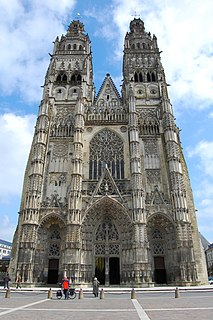
Tours Cathedral is a Roman Catholic church located in Tours, Indre-et-Loire, France, and dedicated to Saint Gatianus. It is the seat of the Archbishops of Tours, the metropolitan cathedral of the Tours ecclesiastical province. It was built between 1170 and 1547. At the time construction began, the church was located at the south end of the bridge over the Loire, on the road from Paris to the south-west of France. It has been a classified monument historique since 1862. Since 1905 it has been owned by the French State, with the Catholic Church having the exclusive rights of use.
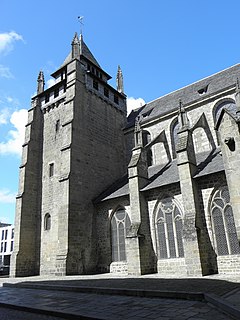
Saint-Brieuc Cathedral is a Roman Catholic church located in the town of Saint-Brieuc, Brittany, France, and dedicated to Saint Stephen.

Nantes Cathedral, or the Cathedral of St. Peter and St. Paul of Nantes, is a Roman Catholic Gothic cathedral located in Nantes, Pays de la Loire, France. Construction began in 1434, on the site of a Romanesque cathedral, and took 457 years to finish in 1891. It has been listed since 1862 as a monument historique by the French Ministry of Culture.

Dol-de-Bretagne Cathedral is a Roman Catholic church located in Dol-de-Bretagne. The cathedral is dedicated to Saint Samson, one of the founding saints of Brittany. It was formerly the seat of the Archbishop of Dol, one of the nine ancient bishoprics of Brittany. The cathedral suffered badly from the excesses of the French Revolution, becoming successively a "Temple de la Raison", then a stable, then a warehouse. Revolutionaries caused considerable damage and many treasures were lost. When it eventually returned to being a house of worship, its role as a bishopric was abolished by the Concordat of 1801 when the Dol diocese was merged into the Dioceses of Rennes and Saint-Malo. The Concordat of 1801 was an agreement between Napoleon and Pope Pius VII, signed on 15 July 1801 in Paris, which sought national reconciliation between revolutionaries and Catholics. The Concordat was abrogated by the law of 1905 on the separation of church and state.

Saint-Malo Cathedral is a Roman Catholic Cathedral located in Saint-Malo, Brittany. The church was founded in dedication to Saint Vincent of Saragossa, and constitutes a national monument of France. It was built in a mix of Roman and Gothic styles during the episcopacy of Jean de Châtillon (1146-1163) on the site of an ancient church founded in the 7th-century. The cathedral suffered damage during WW2 when the steeple toppled onto the Sacred Heart Chapel. An organ which had been built in 1893 by Louis Debierre was destroyed. On 21 May 1972, after twenty-eight years of work, a ceremony was held to celebrate the completion of the restoration.

Mathurin Crucy was a French architect and urban planner, who conceived a major Neo-Classical architectural programme for Nantes.
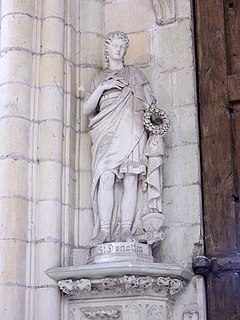
Donatian and Rogatian were two brothers, martyred in Nantes during the reign of Roman Emperor Maximian, around 288-290, for refusing to deny their faith. They are also known as les enfants nantais. Their feast day is 24 May.
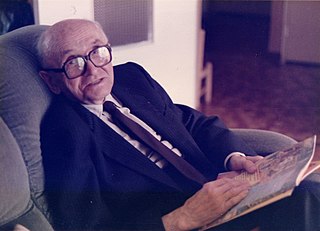
Jean Malo-Renault was a French librarian. Malo-Renault was born in Paris on 9 June 1900 into a family originating from Saint-Malo. He was the son of the pastellist, engraver and illustrator, Émile Malo-Renault, real name Émile Auguste Renault, and his wife Honorine Césarine Tian, herself a printmaker, etching in color.
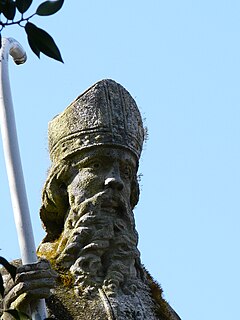
According to late traditions, Saint Clair was the first bishop of Nantes, France in the late 3rd century.

Jean-Baptiste-Antoine Lassus was a French architect who became an expert in restoration or recreation of medieval architecture. He was a strong believer in the early Gothic architecture style, which he thought as a true French and Christian tradition, and was opposed to the classical Graeco-Roman styles promoted by the academic establishment.
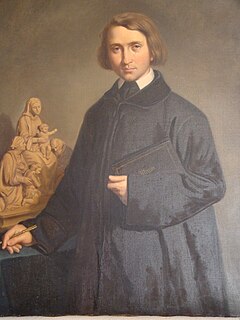
Jean-Marie Valentin, was born at Bourg-des-Comptes in Ille-et-Vilaine on 17 October 1823 and died in Paris on 8 August 1896. He was an architect and a sculptor specialising in religious furnishings such as pulpits, altars and statues. His father Antoine Louis Valentin was a master carpenter working mostly in ebony. He was born in 1784. Jean-Marie first worked at his father's workshop.
Jean de Dammartin or Jehan de Dammartin sometimes spelled Dampmartin (14th-century in Jargeau was a 15th-century French architect.

Jehan (Jean) Texier or Le Texier, better known as Jehan (Jean) de Beauce was a 15th/16th-century French architect. He is known for his works of religious architecture, notably on the Chartres cathedral of which he reconstructed the northern spire.
Tugal Caris, also spelled Carris or Cariste, was a 17th-century French sculptor and architect.
Albert Le Grand was a Breton hagiographer and a Dominican brother.